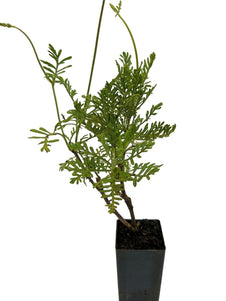
Lavender - Canary Island Lavender
Lavender - Canary Island Lavender
- Low stock - 1 item left
- Inventory on the way

Usually available: All year
Life cycle: Perennial
Height: 50 - 90cm
Position: Full sun
Soil preference: Well drained
This is how we pack and send your Herb Plants to all states except TAS & WA
You will receive
- 1 Canary Island Lavender Herb Plant in a 50 X 75mm tube - General growing instructions
All of our Herb Plants are grown organically with certified organic potting mixes and fertilizers
Botanical Name: Lavandula canariensis
The Canary Island Lavender is a low spreading perennial shrub that grows from 50-90cm tall and wide. It has a woody shrub like structure than other lavenders, which may retain a soft appearance for several years. The fresh green-grey leaves are dainty, pinnate and take on a fern like appearance. The brilliant blue -lilac flowers are held on tall bare stalks that stand out among the foliage. Interestingly this lavender does not have an aroma or perfume to the leaves or flowers. There are gardeners that report a mild fragrance but this may be subjective. The long flowering period begins in spring in its native habitat, where the blossoms put on a colourful show against the background of low native scrub. This lavender is quite different from other lavenders in flower and leaf structure.
Lavandula canariensis is one of many unique species of plant found growing naturally on the islands of Tenerife, Gran Canaria, La Palma, La Gomera and El Hierro, which collectively form the Spanish Canary Islands. The preferred habitat for this lavender is rocky and dry ground, wastelands, hillsides and coastal areas. The volcanic islands lie to the south of Spain and Portugal, off the Moroccan coast and have a subtropical climate. In Spanish, this lavender is called Mato Risco or Lavanda. There are also scientific synonyms in use including Lavandula pterostoechas, Lavandula pinnata and Lavandula buchi.
Lavender is a much loved garden plant with a long history and many modern cultivars. The Lavandula genus belongs to the Laminaceae family, which is also known as the mint family. It has over 3500 species, from more than 180 genera, distributed across the globe. Most of this family of plants come from the Mediterranean and regions with similar climates. They are well suited to growing in the wide range of Australian conditions.
Lavender use has been recorded since ancient times, with uses as varied as early cleansers and perfumes, medicinal headache treatments in the Renaissance Period, and even as an insect repellent. The name ‘lavender’ is derived from the word ‘lavare’ which means ‘to wash’. This reflects the early use of lavender plants in bath houses throughout Ancient Greece and Roman culture. Lavender was also spread around the floors and streets during the Middle Ages, to mask bad household odours and the stench from the streets. Keeping lavender leaves and flowers in small pillows, placed among clothing, as a moth and silverfish repellent is still practised. Today, there is a growing industry providing lavender oil for aromatherapy, cosmetics and cleansers.
It is clear that lavender is a multi-purpose garden plant with great potential, beyond its ornamental value. Each variety is distinctive and may have different properties. For further information please check our other lavender plant listings.
Growing Conditions
Generally, the natural habitat of lavender is characterised by dry, rocky or poor soil and low water conditions. However, there are some cultivars with higher water requirements than others, so it is best to seek information on specific varieties in our other listings. Many evolved with a requirement for high calcium and magnesium and this is commonly present in the natural environment. Depending on local conditions, garden plants may need supplements to grow well.
Canary Island Lavender is low maintenance and tolerant of a wide range of conditions. It is one of the lavenders suitable for cooler regions, with temperatures at low as 10 C that also remain frost free. It performs best in full sun and requires a well-drained soil. The ideal soil type is dry, rocky ground that allows good drainage, although in summer the plant will benefit from regular watering. This lavender is adapted for coastal conditions and may prove to be a good choice for seaside gardens. Pruning after flowering will help the plant maintain a tidy appearance.
Medicinal Uses
Canary Island Lavender has a long history of traditional and folk medicine use on the Canary Islands due to its medicinal properties. It was especially used as a relaxant, to bring down fevers, as a vermifuge and anti-parasitic treatment, a skin disinfectant, to treat stomach problems, for muscle aches and as an anti-inflammatory. It was also considered a valuable remedy for insect bites and stings.
Culinary Uses
Canary Island lavender has very little flavour or scent and is not useful for cooking.
All information provided on this website is for informational purposes only. Please seek professional advice before commencing any treatment.




